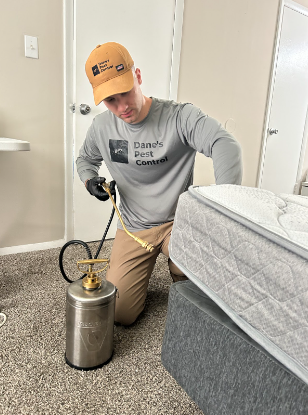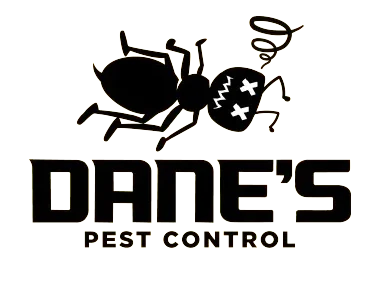Bed Bug Treatment
starting at $ 150 /per Room !

Get More Information

we will not share or spam you

Dane’s Pest Control
- Family owned and operated
- Huntsville pest knowledge
- Effective Solutions
- Fast Customer Service
Contact us today!

Huntsville’s Trusted Pest Experts
What Our Customers Are Saying
EXCELLENTBased on 180 reviews Trustindex verifies that the original source of the review is Google.
Trustindex verifies that the original source of the review is Google. Santhanasurya Athmalingam2024-10-04They respond quickly whenever I reach out, and if there’s any sign of pest activity after treatment, they come back without hesitation for extra visits. Great service and highly reliable!Trustindex verifies that the original source of the review is Google.
Santhanasurya Athmalingam2024-10-04They respond quickly whenever I reach out, and if there’s any sign of pest activity after treatment, they come back without hesitation for extra visits. Great service and highly reliable!Trustindex verifies that the original source of the review is Google. Adam Smith2024-10-04I really appreciate Dane and the work he did for me. I had a very big problem with bugs, and after only 2 treatments, I have seen a tremendous decrease in the amount of pests I had. He was very informative and helpful with any questions I had. I would highly recommended their services to anyone dealing with a pest problem. Great price and even better service.Trustindex verifies that the original source of the review is Google.
Adam Smith2024-10-04I really appreciate Dane and the work he did for me. I had a very big problem with bugs, and after only 2 treatments, I have seen a tremendous decrease in the amount of pests I had. He was very informative and helpful with any questions I had. I would highly recommended their services to anyone dealing with a pest problem. Great price and even better service.Trustindex verifies that the original source of the review is Google. Anthony Shane2024-10-04Gave great deal. Did everything they promisedTrustindex verifies that the original source of the review is Google.
Anthony Shane2024-10-04Gave great deal. Did everything they promisedTrustindex verifies that the original source of the review is Google. Laurin Mitchell2024-10-02Highly recommend! Very professional and friendly. Ben will come out whenever you ask him to even in between the quarterly visits!Trustindex verifies that the original source of the review is Google.
Laurin Mitchell2024-10-02Highly recommend! Very professional and friendly. Ben will come out whenever you ask him to even in between the quarterly visits!Trustindex verifies that the original source of the review is Google. Eduardo Gonzalez2024-09-30Ben and his team are extremely professional, reliable, and reasonably priced. Would highly recommend to anymore needing pest control. He is your guy!!Trustindex verifies that the original source of the review is Google.
Eduardo Gonzalez2024-09-30Ben and his team are extremely professional, reliable, and reasonably priced. Would highly recommend to anymore needing pest control. He is your guy!!Trustindex verifies that the original source of the review is Google. Jalyn2024-09-30Ben is very professional and knowledgeable. I had a problem with spiders in my home for a few months. My previous pest control company came out several times and couldn’t get rid of the spiders. I contacted Ben, and he was able to get rid of the problem. I’m extremely satisfied with his services.Trustindex verifies that the original source of the review is Google.
Jalyn2024-09-30Ben is very professional and knowledgeable. I had a problem with spiders in my home for a few months. My previous pest control company came out several times and couldn’t get rid of the spiders. I contacted Ben, and he was able to get rid of the problem. I’m extremely satisfied with his services.Trustindex verifies that the original source of the review is Google. Madi Brooks2024-09-25I called and he fit me in same day!! Issues were resolved within just days and anytime I see a bug I call him and he is there!!😭 Reliable and nice gentleman, he gets the job done. I have family who also use Danes pest control, would definitely recommend!Trustindex verifies that the original source of the review is Google.
Madi Brooks2024-09-25I called and he fit me in same day!! Issues were resolved within just days and anytime I see a bug I call him and he is there!!😭 Reliable and nice gentleman, he gets the job done. I have family who also use Danes pest control, would definitely recommend!Trustindex verifies that the original source of the review is Google. Ethan Wilson2024-09-24They have been great. Super responsive and fixed my pest problem quickly.
Ethan Wilson2024-09-24They have been great. Super responsive and fixed my pest problem quickly.
Learn More Information Here

Get rid of BedBugs today by calling our Huntsville BedBugs Experts
Call Us at 256 795-6590 or contact us online now!
Fleas are not only bothersome but can also transmit diseases and cause allergic reactions in both humans and pets in Huntsville. Flea bites may result in itchy, red welts and, in severe cases, even contribute to dermatitis or secondary infections. Given the variety of flea species and their adaptability, they can thrive in various environments, making it crucial to address infestations Quickly. Whether they infest indoor spaces or linger in outdoor areas, fleas require immediate attention. If you’re dealing with a flea problem, don’t hesitate to reach out for professional assistance today!
BedBugs Species In Huntsville AL
What are bed bugs
The most common species of bed bugs involved with human infestations are Cimex lectularius and C. hemipterus, these reddish-brown insects feed on the blood of humans and animals, typically during the night. These nocturnal pests are adept at hiding in cracks and crevices, including mattress seams, bed frames, and furniture. Infestations are characterized by itchy, red bites often found in clusters or lines on the skin, dark fecal spots on bedding, blood stains on sheets, and shed skins. Though they do not transmit diseases, bed bugs can cause significant discomfort, stress, and sleep disruption. Effective management requires thorough inspection and professional pest control services.
How to know if you have bed bugs
Identifying a bed bug infestation involves looking for several key signs. Here are some steps and indicators to help you determine if you have a bed bug problem:
- Bites on Your Skin:
- Look for small, red, itchy bites, often in clusters or a line pattern, usually on exposed skin areas like the arms, neck, and face.
- Live Bed Bugs:
- Bed bugs are small, flat, oval-shaped, and reddish-brown. Adult bed bugs are about the size of an apple seed. They can often be found in mattress seams, bed frames, headboards, and other furniture.
- Bed Bug Excrement:
- Look for small, dark, or rusty-colored spots on sheets, mattresses, walls, and other surfaces. These spots are bed bug feces.
- Blood Stains:
- You may find small blood stains on your sheets or pillowcases, which can occur if you crush a bed bug while sleeping.
- Eggs and Eggshells:
- Bed bug eggs are tiny, about 1mm in size, white, and oval-shaped. They are usually found in clusters in cracks and crevices.
- Shed Skins:
- As bed bugs grow, they shed their skins. Look for these light brown, translucent exoskeletons in areas where bed bugs are hiding.
- Musty Odor:
- A large infestation may produce a sweet, musty odor due to the bed bugs’ scent glands.
- Thorough Inspection:
- Check all potential hiding spots, including:
- Mattress seams and tags, box springs, and bed frames.
- Behind headboards, in cracks and crevices of furniture.
- Under chairs, couches, and between cushions.
- In the folds of curtains, along carpet edges, and in electrical outlets.
- Check all potential hiding spots, including:
- Use of Detection Tools:
- Consider using bed bug detection tools like traps or monitors that can help confirm their presence.
How to prevent bed bugs
Preventing bed bugs involves a combination of vigilance and proactive measures Since bed bugs are often inadvertently introduced into homes through various means. They can hitch a ride in luggage, clothing, or personal belongings from infested hotels, motels, and from bringing items into the home. Here are some steps you can take to keep bed bugs out of your home:
- Inspect Secondhand Items: Carefully inspect used furniture, mattresses, and clothing for signs of bed bugs before bringing them into your home.
- Be Cautious When Traveling:
- Inspect hotel rooms for signs of bed bugs, such as stains or shed skins, especially around the bed and furniture.
- Keep luggage elevated on luggage racks and away from the bed.
- Upon returning home, wash and dry all clothing on high heat, and vacuum or steam clean your luggage.
- Regular Home Inspections: Periodically check your mattress seams, bed frames, and surrounding areas for signs of bed bugs, especially if you have recently traveled or brought in secondhand items.
- Reduce Clutter: Keep your home tidy and reduce clutter, which provides hiding spots for bed bugs and makes inspection and treatment more difficult.
- Use Protective Covers: Encase mattresses and box springs in bed bug-proof covers to eliminate hiding spots and make it easier to spot signs of an infestation.
- Seal Cracks and Crevices: Repair or seal cracks in walls, floors, and furniture to reduce potential hiding places for bed bugs.
- Be Cautious with Shared Laundry Facilities: Use plastic bags to transport laundry to and from shared facilities, and use high heat settings to kill any potential bed bugs.
- Monitor and Act Quickly: If you suspect a bed bug infestation, act quickly to confirm their presence and contact a professional pest control service for effective treatment.


